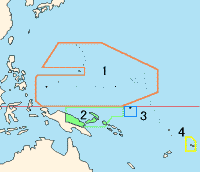| Tenure | Portrait | Incumbent | Notes |
|---|
In 1900, according to the Tripartite Convention and following the Second Samoan Civil War, the Samoan Islands were annexed by the German Empire, except for the part that is to become American Samoa. [1]
Wilhelm II, the German Emperor, is styled "Tupu Sili o Samoa" ("Paramount King of Samoa"). [2] |
| Governors of German Samoa (1900–1914) |
|---|
| 1 March 1900 to 19 December 1911 |  | Wilhelm Heinrich Solf | Afterwards served as the Secretary of State in the Reichskolonialamt, from 1911 to 1918 |
| 19 December 1911 to 29 August 1914 |  | Erich Schultz-Ewerth | Acting to 19 June 1912 |
| In 1914, as part of the Asian and Pacific theatre of World War I, an expeditionary force from the Dominion of New Zealand called the Samoa Expeditionary Force (SEF) captured and occupied the territory. In 1920, the territory was turned into a League of Nations mandate, administered by New Zealand. In 1946, the mandate was reformed as a United Nations trust territory and continued to be administered by New Zealand. |
| Administrators of Western Samoa (1914–1948) |
|---|
| 29 August 1914 to 28 January 1919 |  | Colonel Robert Logan | |
| 28 January 1919 to 16 March 1923 |  | Colonel Robert Ward Tate | |
| 16 March 1923 to 8 April 1928 |  | George Spafford Richardson | From 3 June 1925, Sir George Spafford Richardson |
| 5 May 1928 to 3 April 1931 |  | Stephen Allen | |
| 18 April 1931 to 25 July 1935 |  | Herbert Ernest Hart | |
| 25 July 1935 to 28 February 1946 |  | Alfred Turnbull | From 1942, Sir Alfred Clarke Turnbull; acting to 1943 |
| March 1946 to 10 March 1948 |  | Francis William Voelcker | |
| High Commissioners of Western Samoa (1948–1961) |
|---|
| 10 March 1948 to 23 February 1949 |  | Francis William Voelcker | |
| 1 March 1949 to 2 April 1960 |  | Guy Powles | |
| 2 April 1960 to 31 December 1961 |  | Jack Wright | Acting to June 1960 |


















